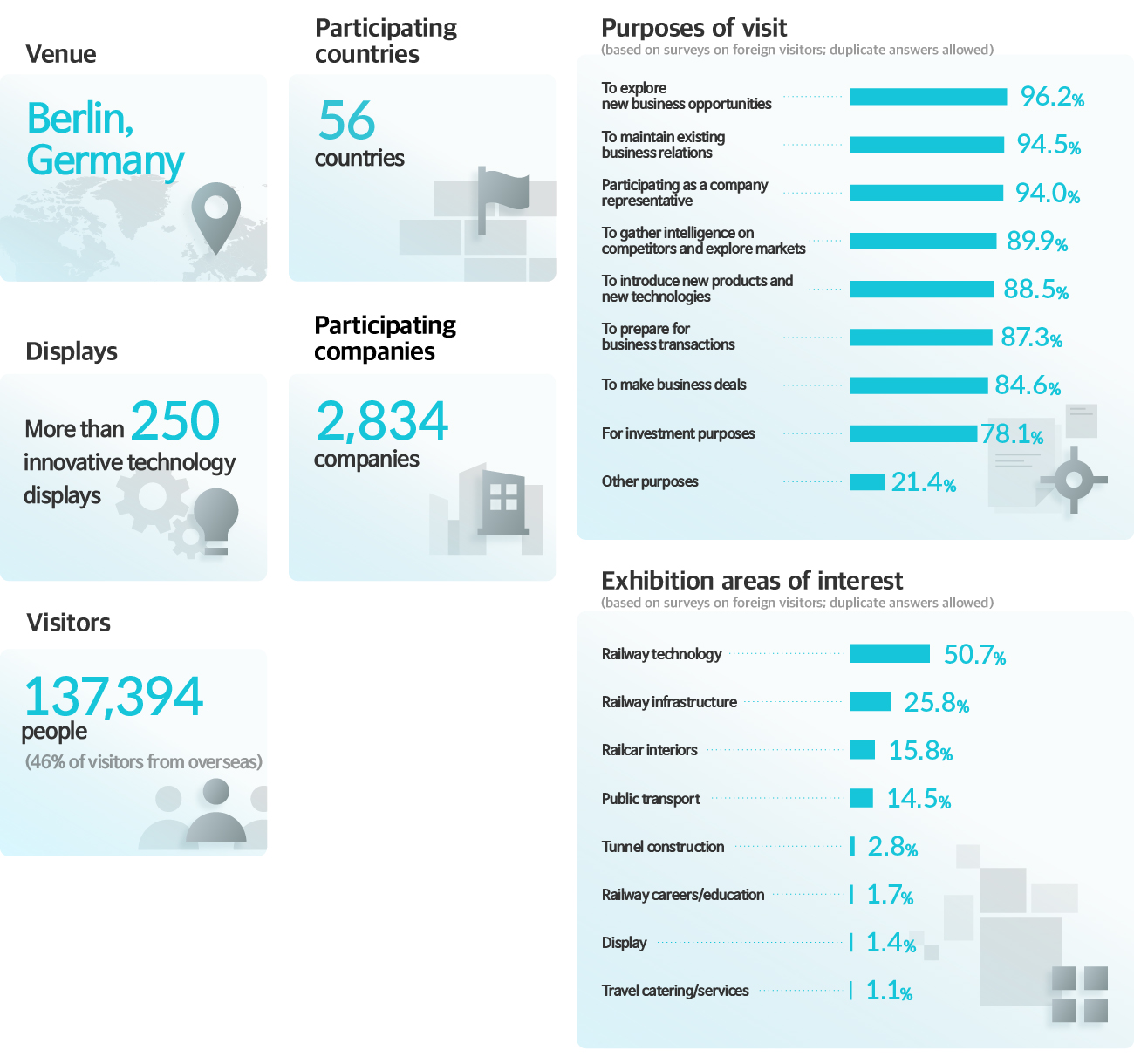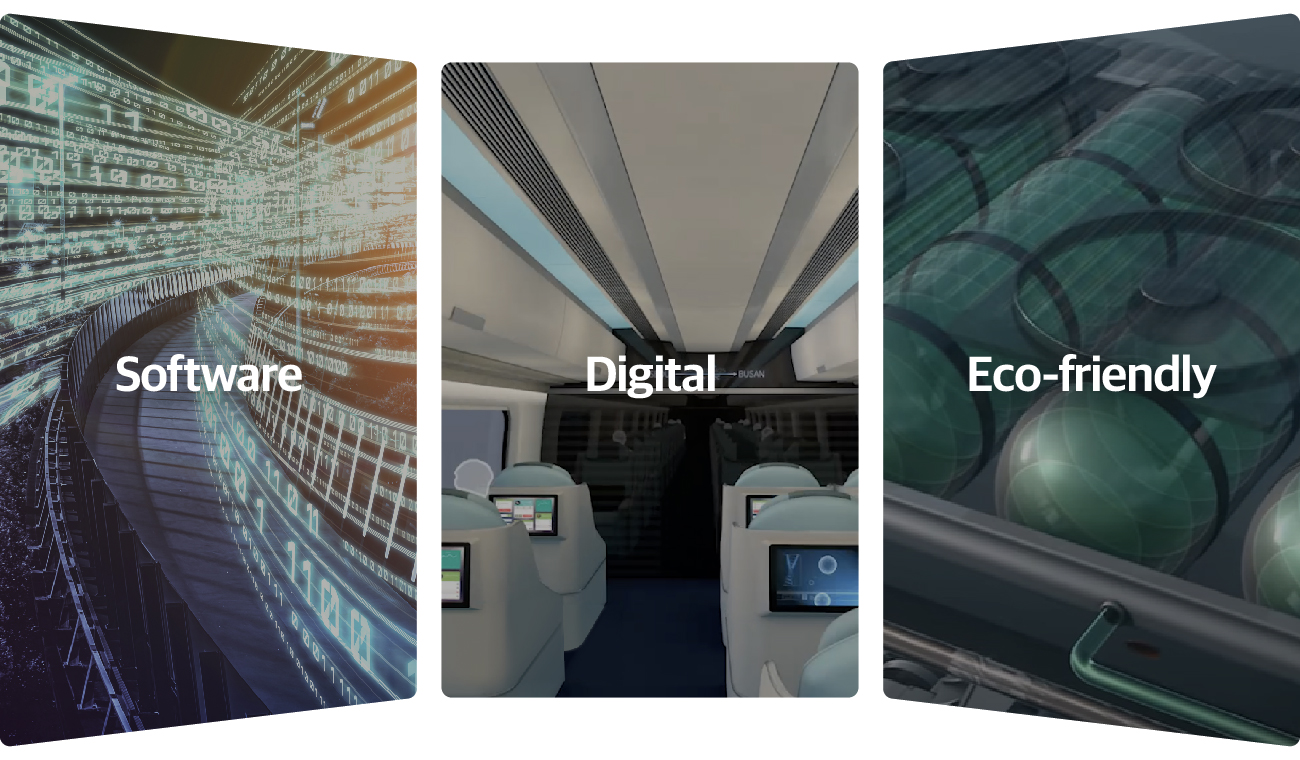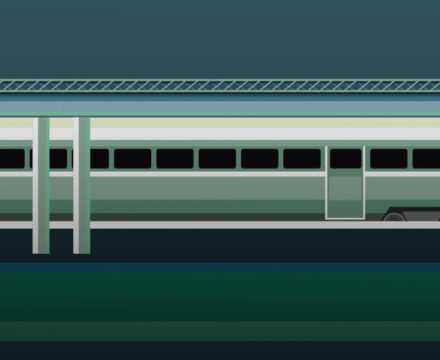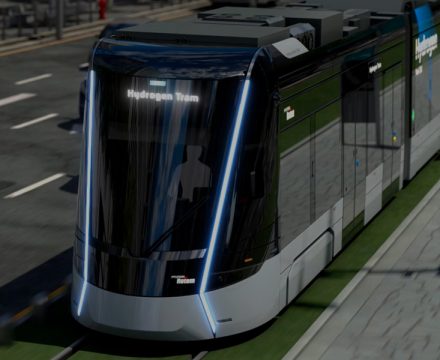
From September 20 to 23, the International Trade Fair for Transport Technology (InnoTrans 2022), was held in Berlin, Germany. The exhibition, which celebrated its 13th anniversary this year, was originally scheduled to be held in 2020, but was postponed for two years due to COVID-19, and so was held for the first time in four years. InnoTrans 2022 was a large-scale exhibition occupying all 43 halls of Messe Berlin, subdivided into five categories: rail technology, rail infrastructure, public transport, interiors, and tunnel construction, providing a glimpse into the present and future of the global railway industry. In the outdoor stage where actual railcars were on display, visitors were able to experience next-generation trains firsthand.
Major info about InnoTrans 2022

The number of exhibitors and visitors at InnoTrans 2022 slightly declined compared to those of the previous event in 2018, due to the impact of COVID-19. Still, a large number of world-class companies on the edge of global railway technology trends, such as Siemens, Alstom, CRRC, Stadler, and Hitachi, took part in this long-awaited railway expo, presenting a variety of things to see. At InnoTrans 2022, about 2,834 companies from 56 countries around the world participated, showcasing 250 railway-related innovative technologies, and 137,394 visitors from 131 countries came to the Berlin event to see it firsthand.
Global railway technology trends at InnoTrans 2022

The main themes of global railway technology seen at InnoTrans 2022 can be summarized in three key words: digital, software, and eco-friendliness. The event presented a variety of displays, focusing on developing and realizing the keynote that has been in place since the 2016 fair. This trend was particularly prominent in the booths of leading railway companies participating in the exhibition.

In this year’s exhibition, Siemens showcased a new open digital business platform: Siemens Xcelerator. This is a new digital business platform that supports an open digital interface for uninterrupted data exchange between all subsystems of the rail network, providing new value to each stakeholder by connecting trains, infrastructure, operators, and passengers.

Alstom introduced its Green Traction solution, along with the latest fuel cell technologies, such as battery packs and hydrogen fuel cells. In addition to eco-friendly technologies, various digital solutions surrounding the safety and efficiency of train car operation were also introduced, such as the Automatic Train Operation (ATO), European Train Control System (ETCS), cyber security technology, and Health Hub, a railcar maintenance optimization solution.

Stadler, Switzerland’s leading railway company, also focused on “digital,” one of the most pressing themes in global railway technology. In addition, the company joined the global hydrogen train trend by introducing a hydrogen-powered electric car, for use in the U.S. for passenger transport. It also showed off seven new rolling stock models with sustainable drive solutions, including battery-powered train cars and hybrid locomotives, while introducing the latest digital solutions in service and signaling technology. Meanwhile, Grupo CAF promoted digital solutions and platforms such as Digital Depot for optimization of railcar operation and maintenance, and LeadMind, based on condition-based maintenance (CBM) and predictive maintenance.
The latest train cars fill InnoTrans 2022

At InnoTrans 2022, various new train cars developed by each company were revealed, in addition to new railway technologies such as digital solutions and software. The Coradia Stream High Capacity train car unveiled by Alstom is a hybrid train car that utilizes several power systems: diesel, electric, and dual mode, and boasts excellent operational efficiency through adoption of highly modular technology. It was designed as a double-decker train car to increase maximum passenger capacity.

The FLIRT H2, presented by Stadler, is the first hydrogen-powered train car to be showcased at the InnoTrans venue. This is a train car commissioned by the San Bernardino County Department of Transportation in the United States, and can travel up to 460 km on a single hydrogen fuel charge. FLIRT Trimodal is a hybrid train car that can charge batteries through a diesel-electric power supply, with the battery and diesel engine (power pack) installed separately from the passenger section. Stadler also displayed its TINA Tram, a next-generation tram car, featuring an integrated collision warning system and a digital interactive driver desk.

As befits the expo held in their own country, Siemens is showing off not only the Mireo Plus H, a hydrogen and battery-powered car, and Mireo Plus B, a wired/wireless hybrid, but also introduced a full lineup of Siemens railcars, including the Vectron Dual Mode electric locomotive, which reduces carbon emissions by 950 tons over standard diesel locomotives. The Mireo Plus H offers a range of up to 1,000 km after just 15 minutes of refueling. According to Siemens, the operation of the new train car can reduce carbon dioxide emissions by 520 tons a year.
Hyundai Rotem’s railway technology in 2022


Hyundai Rotem also showcased advanced railway technology from Korea at InnoTrans 2022. Hyundai Rotem’s main display items at the latest exhibition include the tram supplied to Warsaw, Poland, the hydrogen fuel cell system, as well as the real Korean train control system (KTCS), and small scale model of hydrogen fuel cell trams, hydrogen production, refueling stations. On the opening day, a hydrogen launch event was held to showcase to the world the hydrogen vision imagined by Hyundai Rotem, hydrogen fuel cell rolling stocks, and the capability to supply integrated solutions for hydrogen production and refueling infrastructure.


At this event, Hyundai Rotem focused on hydrogen-related technology, which has been highlighted as a new energy source. In their indoor booth, Hyundai Rotem exhibited a 1:15 scale model of a hydrogen tram, manufactured as part of the hydrogen electric tram demonstration project sponsored by Korea’s Ministry of Trade, Industry and Energy. In addition to the hydrogen tram model exhibition, the company also presented a mid- to long-term roadmap for hydrogen vehicle development that continues from trams to rolling stock, locomotives, and high-speed railways. In addition, Hyundai Rotem’s technological prowess throughout hydrogen infrastructure was widely promoted by exhibiting a power converter box that moves a hydrogen train, a model of the hydrogen reformer, a hydrogen production facility, and a model of the hydrogen transport and refueling station.

The company also exhibited the KTCS on-board signaling system, an innovative technology in the railway signaling area, at InnoTrans 2022. It is a signaling system custom-tailored to the Korean railway environment. It can control trains through two-way wireless communications, and is based on Long-term Evolution-Railway (LTE-R) technology. In April 2022, Hyundai Rotem completed the KTCS-2 pilot project on the Jeolla Line, which can respond to high-speed trains of 200 km/h or higher, through the development and localization of the on-board equipment. It is also undertaking a KTCS-M pilot project for urban railways on the Ilsan Line. For reference, KTCS standardized data transmission is based on the European Train Control System (ETCS). The company plans to target the world’s train signaling system market, based on KTCS R&D and pilot project outcomes.

In addition, the company also ran a VR and AR zone where visitors could experience the train environment through virtual and augmented reality. Thanks to these installations, visitors were able to get firsthand experience on train operation and maintenance for driver training through VR, and vehicle maintenance training offered by Hyundai Rotem through AR.

At an outdoor exhibition hall, Hyundai Rotem displayed the recently delivered tram to the City of Warsaw in Poland. This is a low-floor tram car currently in service in Warsaw. The main features of the car, such as an energy saving system, ultra-capacitor, and pivot bogie, were introduced.
In this way, Hyundai Rotem was able to once again prove the excellence of Korea’s railway technology at InnoTrans 2022, where the world’s leading railway companies participated as exhibitors. Hyundai Rotem plans to showcase the vision and technology for the future railway industry through various channels around the world and continue to take steps to enhance the competitiveness of Korea’s railway industry.



